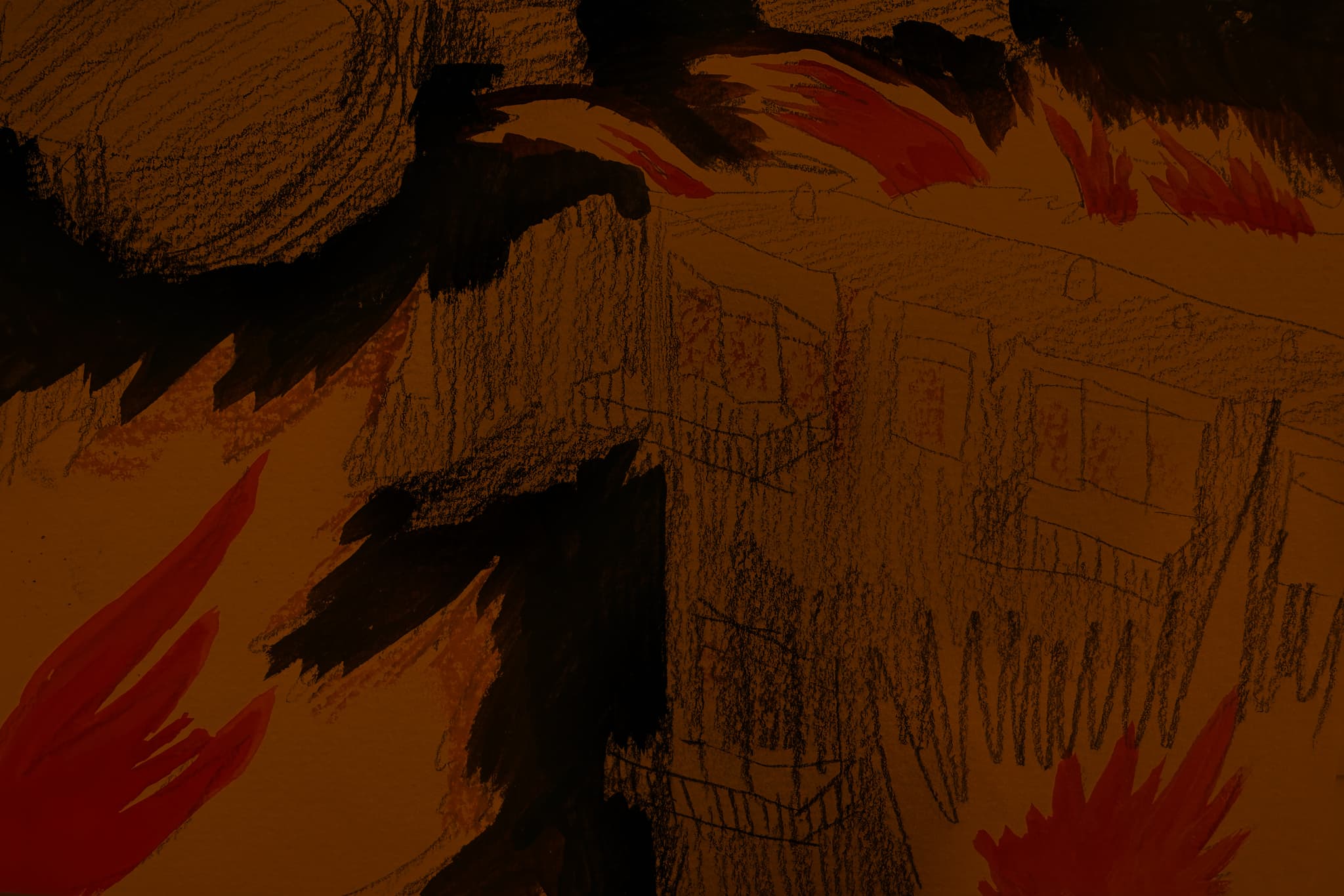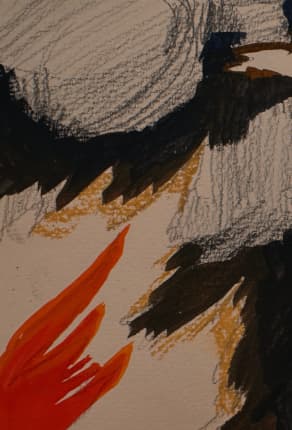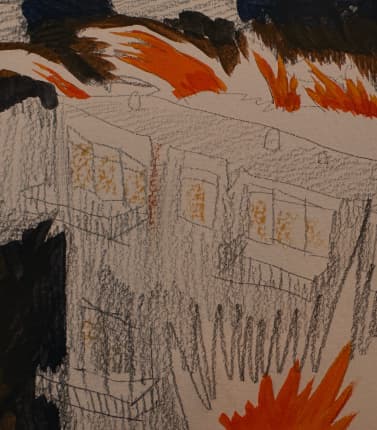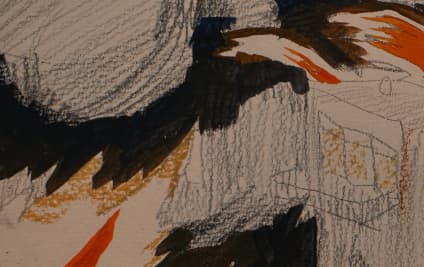When an Hurricane-Force Fire Devastated our City, We Were Faced with the Unthinkable

Fire Recovery Resources for Artists
When an unexpected urban firestorm hits your studio, here are resources
Resources to Share with Fellow Artists
Why we made this compilation
First, if you're reading this, I'm so sorry you or someone you know are going through a disaster. We can only imagine how you must be feeling right now.
While the trauma of every fire is unique, there are common institutions you'll need to navigate, and there are some hard-won experiences that are transferrable. For example, you may learn (if you don't already know) that it is the smoke, ash and soot (from urban fires especially) are extremely hazardous— not just the fire itself. These can cause total loss even if the flames did not touch your house.
One of the best pieces of wisdom we heard came from a fellow fire survivor: to seek as many different sources of information and recommendations as you can and weigh it for yourself. So it is in that spirit that we offer our experiences.
There are several whole fields of knowledge which fire survivors have to learn— insurance, state and governmental regulations, remediation, interpretation of the work of industrial hygienists and chemists— just to name just a few.
There is a gauntlet to face after the trauma and loss, and that is why we wanted to compile some of the things we found helpful in navigating our own journey after a large-scale natural disaster, and we hope this will be a helpful voice among many.
What inspired this resource was our own experience as survivors— we were faced nightmare scenario wherein hundred-mile-an-hour winds drove an explosive urban wildfire through two towns and nothing could be done to stop it.
Our studio survived the initial blaze but was hit with the second hazard- contamination with soot, ash, and a cocktail of toxic chemicals from a thousand burning homes, garages, cars, basements, and businesses.
This experience eventually led to the founding of Paint List, as we wanted to share The Great Book of Color with fellow painters. It easily could have been lost that day.
One of the main things we've gleaned in talking with other survivors is that you're having to make so many decisions based on incomplete knowledge and some of those decisions may need to be made right now. Recovery from this kind of event is a whirlwind. Use your best judgement to make the best decision you can with the information you have and let yourself move on-- the perfect decisions do not exist. You'll have to use the best knowledge you have at the time, and that knowledge is incomplete. Some of those decisions may feel like the wrong decision in retrospect, but letting yourself go on is part of this. It's not possible to make all the right decisions, and it's more about doing the best that you can. It's an ordeal.
Every disaster is different, so with that in mind, here are some well-established resources which were useful to us in the midst of a disaster and would also apply to the 2025 California Wildfires.

If you are going through an urban wildfire, we are so sorry you are having to experience this
Quick Links for Fire Survivors
Whether you were affected by the flames or the soot, char, and ash, here are some basic educational resources
We found Sean Scott's Red Guide to Recovery to be invaluable, as well as his research on smoke/ash toxicity and remediation. This article on dioxins is a must read— almost no one knows just how toxic smoke and ash really are.
For insurance, United Policyholders was a very important resource for understanding the insurance industry, and we recommend their YouTube channel as an immediate help. They will also have online webinars tailored to your fire.
If you are preparing to evacuate Tips for evacuation - Palisades Fire In the end, getting yourself out safely is what matters most.
Once You Are Safe If you have insurance: United Policyholders - link specific to California Wildfires 2025. See also the California Division of Insurance
Resources compiled by a community of urban firestorm survivors This helpful document was compiled by our community of survivors from the Marshall Fire. Things to think about, practical immediate advice (such as taking a screenshot of your house on Zillow right now before values change) with additional resources compiled which are specific to the current 2025 fires in California.
On the Toxicity of Fire Environments It is so tempting in the grief of immediate loss to want to re-enter a fire environment right away, but most people do not understand how hazardous it is.
Urban ash is far more toxic than anyone ever realized and can create a total loss. Marshall Fire survivors found this out firsthand in a terrible saga that is still unfolding three years later. What might look like too much PPE is actually a bare minimum, and we urge people not to expose themselves to the ash (this is based on statements from governmental health authorities made in the wake of other massive urban fire disasters).
Here are some resources from experts such as Sean Scott: The Most Hazardous Substance in Structure Fire Environments
Free Resources from the Red Guide to Recovery -See Sean Scott's work on Lead Contamination, Toxic Smoke Particulates, Limitations of Remediation Protocols, etc. Our take (insert the caveat that we are not toxicologists) is that the heavy metals and dioxins/furans are very serious. Many tests from the fire we went through came back positive for lead, dioxin, etc. Unfortunately remediation is not designed for this. Sean Scott's work showed that even the remediated soft goods were still contaminated with heavy metals in the testing he had done. We recommend finding and studying his test results as well as his recommendations for working with insurance. We highly recommend his books.

Urban fires are far more toxic than most people ever realize
Some Thoughts Based On Our Experiences
Every fire is different, but there are some hard-won insights that you will keep forever
Unfortunately, the insurance battle is likely to be difficult. The state Division of Insurance may be helpful. We wished we had consulted a lawyer sooner in our own process. As soon as we did, it sped the process along efficiently. Of course, every situation is different, and you'll have to assess your own needs.
Here are some suggestions based on our experiences:
Protect yourself from the air and ash near a fire environment, even if the structure itself didn't burn-- PPE is extremely important. Research the proper level of PPE even if everything looks normal, and acquire the proper gear before going back in— a mask is not enough. So many people experienced adverse symptoms in the urban wildfire we went through. That house that's still standing? Very toxic.
Buy a designated notebook to write down everything that happens. Write down any conversations with adjusters, health professionals, etc. so you have them, along with dates. Some suggest emailing these to yourself as well. This book is going to be very important.
Save every receipt. We bought a designated receipt holder to keep it all organized.
Make a designated email address for all fire-related sign-ups or correspondence (e.g. with insurance). This will save yourself a lot of hassle. Unfortunately with the many sign-ups and programs we have also heard about egregious data breaches, even from established organizations or civic sources. Consider opening a designated bank account for insurance as well.
Educate yourself on insurance. United Policyholders has resources for every step of the insurance journey. You can find long-form webinars on YouTube and subscribe to their newsletter to tune into their webinars related to your particular disaster event.
Find out about the toxicity of smoke and ash. Many chemicals burn in an urban fire and current remediation practices do not necessarily address this. See The Most Hazardous Substance in Structure Fire Environments. Basic PPE is not enough.
Begin looking for housing- be proactive and do not wait. If you're displaced, look for a long-term rental option as soon as possible.
If your home is still standing or near a fire: contact industrial hygienists, ask what kinds of tests they do, what their rates are, and research their qualifications. Again, you'll need to be proactive and advocate for your own health. Do not rush in to move or clean anything yourself - wait to get it tested. Heavy metals and dioxin are common in structure fires and these are not included in basic soot/char/ash tests.
Buy water. The water after disasters is often contaminated for various reasons -- this happened to residents in our disaster and took months/years to really resolve. This is a common refrain from other fires as well.
Research air quality. This is obviously a very personal decision (as are most things on the fire recovery journey) but one that many survivors including ourselves opted to do was to choose a rental away from town. The air quality after a fire is affected by VOCs and compounds off-gassing as well as smoldering areas and blowing ash. However there are also longer term issues as the soil and ash are going to be continually disturbed through the rebuilding cycle. There were many days in our disaster where the ash was on the wind and there were rules that people had to cease certain building activities if winds were above a certain threshold. We opted to relocate to a new area in the aftermath due to air quality concerns. Another issue to consider are debris flows and flooding in the seasons after a disaster.
Make and Manage Your Own Basic Loss Inventory If you lost contents to the fire, make a spreadsheet of your own to detail your items. Insurance companies use their own software which can be far less user-friendly, and ultimately confusing-- and there is the risk of something going wrong. We heard horror stories from fellow survivors of insurance companies glitching out the survivor's inventory in the middle of their harrowing documentation process. Consider building your own spreadsheet (mac numbers or excel) if even for your own organization, peace of mind, and the option to keep it all together in one place. This can be exported to the insurance company or used as a reference to track what you've submitted through their portal. United Policyholders has a general how-to information and a template to get started.
Consider consulting a lawyer early in your insurance process (united policyholders has resources on this also). There may be pro-bono consultations or services of various kinds.
Contents Can Get Lost. We have heard horror stories of contents getting lost when taken offsite for remediation. Sean Scott has some information about this in his books, and unfortunately it is something we heard from many fellow survivors. Furthermore remediation is not really designed to address the contaminants from urban wildfires and structure fires, so once again do your research.
Also, if you have had to evacuate, please be gentle with yourself. There is no way to save everything in this kind of emergency. Be so kind to yourself in the days and months to come.
We will continue to update this article with more resources.

Links relating to Smoke Damage and Fire Toxicity
Links on Smoke Damage
We came across many articles (some listed below) in our own process as we tried to figure out what we were up against in the aftermath of the Marshall Fire. Unfortunately, there were no easy answers. It is known that wildland-urban interface fires or WUIs are associated with a whole host of toxic particulates and residues- most people are not initially aware how toxic these substances can be. This list is by no means comprehensive.
We also looked to air and water quality reports from other WUI fires as we looked for research to emerge surrounding our own fire (bearing in mind that no two fires are exactly alike). Some things came out only after it would have been most relevant to the people in the disaster, as testing, interpreting data, and writing articles takes time. Naturally, you’ll need to do your own research/testing about your own fire situation and come to your own conclusions. As we said earlier, one of the best pieces of advice we heard was to gather information from as many sources as possible and then come to your own conclusions and make the best decisions you can.
Smoke damage experiences from Marshall Fire survivors emerged in the news well after the initial disaster, so these may be of interest to others as well for points of comparison as an example of another WUI fire. Many of these are linked below-- please feel free to add more in the comments.
Some General Information on Fire Particulates Addressing Toxic Smoke Particulates in Fire Restoration -a .pdf hosted by United Policyholders
Fire Remediation Expert David Oakes Weighs in on PPE and Toxic Fire Residues - A remediation industry publication, Cleanfax
California wildfires created toxic chromium, research finds -NBC News
As California reels, study shows Marshall fire made air in nearby homes hazardous for months - Colorado Sun
Fire and Smoke Damage Investigations and Testing Options Webinar from ESML labs on Soot/Char/Ash tests (these basic tests do not usually include heavy metal testing nor dioxin testing)
Topic for further research: When plastics or PVC burn See also: Dioxin in structure fires
DIOXINS & TCDD General info: Dioxins - The Most Hazardous Substance in Structure Fire Environments- Restoration and Remediation Journal
Why do we Worry about Dioxins?-General comments from The Royal Society of Chemistry
Dioxins Produced by Backyard Burning- EPA
Illinois Dept of Health Fact Sheet on Dioxins
Topic for further research: what happened in Oroville, CA re: persistent fire dioxins in soil
Some News Coverage on Standing Homes, Smoke Damage in the Marshall Fire for urban wildfire as a comparison Wildfire smoke’s health risks can linger in homes that escape burning − as Colorado’s Marshall Fire survivors discovered - The Conversation
No return: The unseen toll of the Marshall Fire’s ‘standing home’ survivors - Boulder Reporting Lab
“Air quality issues don’t go away when the fire is out”: Questions remain about long-term Marshall fire health effects -The Colorado Sun
3 Years after the Marshall Fire: Wildfire smoke’s health risks can linger long-term in homes that escape burning -KUNC (local news). May be useful for understanding the impact of WUI fires- however a higher level of PPE may be needed - see the article linked above by David Oakes.
[Smoke Damage a Source of Friction for ‘Standing Home Survivors’]-Claims Journal(https://www.claimsjournal.com/news/west/2022/12/09/314183.htm) If you have insurance, United Policyholders has a page on Smoke Remediation here.
Please consult qualified experts from your particular jurisdiction/disaster. We found it interesting to hear what was involved in other WUI fires even if it didn't apply to our fire specifically. State and/or county health found things like heavy metals in WUI fire residues and debris.
Marshall Fire Asbestos, Lead and other Contaminants in Smoke - Colorado Department of Health, contains general statements on urban fire residues
Colorado Residents Strongly Discouraged Against Disturbing Fire Ash and Debris in Marshall Fire Area: Toxic, cancer-causing substances make recovering belongings dangerous - Boulder County Public Health. Also contains general statements on urban ash.
Academic Research from the Marshall Fire on Smoke Damage and Air Quality in Homes Physical Health Symptoms and Perceptions of Air Quality among Residents of Smoke-Damaged Homes from a Wildland Urban Interface Fire
Months after Maui Fire Residents Report Troubling Health Problems - Paid article from Washington Post.
Some Information from other fires such as the Camp Fire in Paradise, CA, for comparison and WUI fire research Elevated levels of metals traveled through the smoke: California Air Resources Board- Camp Fire Report How wildfires can contaminate drinking water: New research shows that the heat causes volatile organic compounds to leach out of plastic service line pipes into water- Chemical Engineering News In California, Houses Burned. So Did the Toxic Chemicals They Contained. - Paid New York Times Article
For Artists Specifically
Processing Loss - Imagining a New Studio and New Artistic Practice
Consider Expanding Your Search beyond Art-Related Grants In Rebuilding Your Studio
The good news is there will likely be grants that are geared toward survivors of the Los Angeles fires. A simple search for "Disaster relief for artists" in general will turn up a lot of resources, but do your research to be sure they are well-established and to avoid being scammed. Unfortunately we heard about data breaches and privacy breaches from agencies that were poised as offering help.
We also recommend inquiring from local sources whether their programs will apply to your situation. Ask everyone and don't stop asking. It may feel exhausting in the wake of a disaster, but your work is worth it.
We also encourage people to approach their local community foundations and seek out any recovery programs or recovery navigators to walk alongside them in this process— even if they do not seem specifically geared to your "category" of loss. They often know about different resources they can recommend to you, even if their particular program can't help. They may know of those who can.
There are often funds earmarked for "unmet needs" during this kind of disaster. See if any of them will support helping to restore your studio.
Things you can have ready are a pdf with pictures of your work, a brief artist statement, along with links to your website.
Art-Related Programs, Grants, Etc. This is not a complete guide, but we'll be adding to this as we find more resources. For those who lost musical instruments: Guitar Center Foundation
Reflecting on the Dimensions of Loss for Artists Specifically
For artists, this kind of an event is particularly difficult because of several elements of our profession. For many of us, our work is physical, and we are loosing not only our homes and sanctuaries but our work life may be seriously impacted as well. There is something unique about art in itself which makes recovery look a little different. While many things can be re-purchased, there is no way to recreate a painting with exactly the same feel, with the same moment of creation infused into its very fibers. The sense of history and progression through a body of work is also something that can't be re-created. That loss is profound.
Housing needs for displaced artists also have different elements. We need a place to make our work in addition to a securing a regular rental. In the time after a fire when real estate is at a premium, it exacerbates an already-difficult housing situation. Sites like The Listings Project can be helpful for finding non-traditional spaces as well as studios.
Additionally, our work often requires expensive specialty supplies, many of which were accrued over a lifetime. Trying to start again is a bizarre experience for anyone, but trying to rebuild a studio may be additionally complex. It takes time. Some of our supplies may have been rare, discontinued, acquired in other countries, or impossible to find again. The worth of these hard-to-find supplies can be estimated through resources like worthpoint.com. To search for replacements, a person can set up email alerts on ebay for rare items.
Finally, insurance tends to be brutal for artists because of the way many policies are written. This happened to us and others we've spoken with other as well. The work is "bankrupted" to be merely the cost of the materials. This is a huge issue for established artists who have lost valuable works of their own making which were being held in inventory.
The loss is incredible.
Our Experience in Rebuilding a Studio
Everyone's path through this loss is unique. Once again it's helpful to seek many opinions on this, and as many recovery sources as you can (e.g. Trauma counseling for natural disasters).
We've found it's important to be extra gentle-- not only with yourself but also in your own expectations and relationship to your work.
It may be helpful to make new work to process the trauma and loss, even if it's work that may or may not end up being something public-facing. For us it has been a bit of a sine curve or wave shape- between making new work and periods of silence. It will look different for everyone and that's ok.
Ideas for pivoting and working light under strange circumstances. While evacuated, we didn't have our usual supplies, and given the circumstances we started small. We bought a watercolor journal along with a cheap brush, just to make some sketches.
One practical task that can be helpful is to find an an art retailer website with a list-saving feature (Blick has this) and compile a list of what you would need to replace what you lost. We made an abbreviated replacement list of just what we would need to pick up where we left off and continue working, and this helped to make the recovery more concrete. This list can also help in seeking grant support or funding, and also can jog a person's memory of what they have lost for insurance purposes.
Sometimes a lot of "it's just stuff" comments get made in the media, but if you've been through it, you know that's not really the whole story. The things we have speak to our history. It's not usually the big-ticket items people miss-- it's things that have almost no monetary value and yet are invested with meaning. The unmooring experience can be profound. The vision of a studio is something inside, not outside, and from that vision can come the inspiration to make a new space. Rebuilding will most likely feel strange, and based on our experience and all those we've heard from, that's totally normal. There are no timeframes for recovery.
Part of the task of rebuilding is finding new meaning, even though everything may feel senseless right now.
Openness to newness may be hard in the loss of the familiar. In terms of the studio, we have been amazed at how certain things we weren't even looking for just showed up at a reduced price or second hand— things we hadn't even hoped to find on our recovery list, and this seemed somehow significant. It felt like serendipity, as we've had to pioneer this strange path which was not of our own choosing.
You will have a gift to give No matter how it feels now, your unique story matters. You have a boon to offer the world based on your experiences.
We wish you the best as you pioneer your unique path through this wilderness. May good things regrow, and may new and unexpected serendipities rise to greet you.
Wishing you the very best, Melissa and Jonathan
Disclaimer: This article is offered in the spirit of kinship, sharing, and goodwill. This article does not constitute legal, financial, or professional advice. No guarantees are made regarding its completeness, timeliness, or suitability for any particular purpose. Any decisions made or actions taken based on the information here are not the responsibility of the authors. Please consult the relevant professionals or agencies for specific advice or assistance. Wishing all affected the very best.
